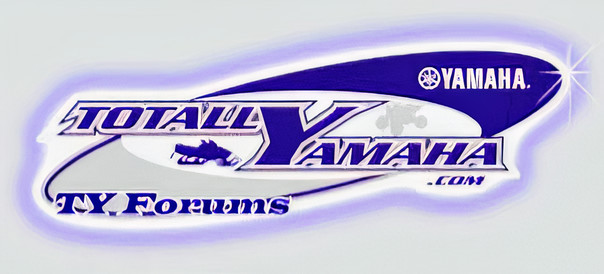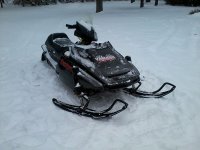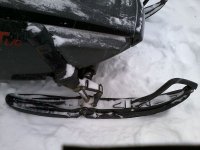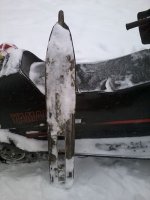By the way...what is the difference between different mains??? Some of mine says 310, 320, 330 and so on... some of them is marked with 140,150, 160?
thefullmonte
New member
The main jets use a numbering system where the larger the number = a larger orifice. Basically the bigger the number the more fuel it will flow = richer.
Same holds true with the pilot jets. Larger number = more fuel.
Mikuni carbs will also have a pilot screw of some sort. If the screw is located towards the back it is an air screw. Turning this in allows less air to mix with the fuel = richer.
If the screw is towards the front it controls fuel flow. So turning the screw out = richer.
The needle can get confusing as the letters designate a specific dimension at a specified length. For the most part, if you lower the clip position you are raising the needle causing more fuel to flow earlier = richer. Move the clip up and the needle drops lower causing less fuel to flow at that specific throttle opening.
Always a good idea to dial in the main jet before changing the needle as they are very closely related. The main jet is ultimately dictating the amount of fuel allowed to flow at wide open throttle. However, the needle is in charge of when the main jet can start flowing that fuel. Over simplification, but hope that helps.
Pretty good write up here. http://www.iwt.com.au/mikunicarb.htm
Same holds true with the pilot jets. Larger number = more fuel.
Mikuni carbs will also have a pilot screw of some sort. If the screw is located towards the back it is an air screw. Turning this in allows less air to mix with the fuel = richer.
If the screw is towards the front it controls fuel flow. So turning the screw out = richer.
The needle can get confusing as the letters designate a specific dimension at a specified length. For the most part, if you lower the clip position you are raising the needle causing more fuel to flow earlier = richer. Move the clip up and the needle drops lower causing less fuel to flow at that specific throttle opening.
Always a good idea to dial in the main jet before changing the needle as they are very closely related. The main jet is ultimately dictating the amount of fuel allowed to flow at wide open throttle. However, the needle is in charge of when the main jet can start flowing that fuel. Over simplification, but hope that helps.
Pretty good write up here. http://www.iwt.com.au/mikunicarb.htm
thefullmonte said:I didn't realize those GREEN UNI pods were that restrictive.
Do not use any other color or model than the specific UNI "Snowmobile" pods.prankster said:Those GREEN UNI's really suck,
gonna buy some RED ones instead.
They have a much more coarse foam that is much better suited for snowmobile use.
Look here : http://www.unifilter.com/online%20catalog/universal.html

Last edited:
Excellent jetting info there monte! But is there a difference between the mains beginning with different first numbers? For example size 150 contra size 310 (310 was my previous mains)? Why are they marked different? Is the size 150 actually the same as size 350?
Lasse where can i buy those in sweden? Bought the last ones on skoterdelen.se
Lasse where can i buy those in sweden? Bought the last ones on skoterdelen.se
thefullmonte
New member
No they are not the same! In fact I think they are completely different jets. 150 sounds like a round jet size and the 350 sounds like a hex that the round slide carbs used.
Regardless, they are going to be at very different ends of the spectrum. A 150 is going to be extremely lean compared to a 350. If they are the same style of jet.
Forgive me, I don't remember if the Vmax carbs were using a hex or round jet as they are different and not compatible. However, they are calling for a 156.3 which again sounds like a round jet sizing.
I don't know how mikuni calculates the flow rates. The sizing and fuel flow is sized much differently from the round to the hex. First better verify what is in there. Maybe someone else can chime in on what is used in those carbs.
Regardless, they are going to be at very different ends of the spectrum. A 150 is going to be extremely lean compared to a 350. If they are the same style of jet.
Forgive me, I don't remember if the Vmax carbs were using a hex or round jet as they are different and not compatible. However, they are calling for a 156.3 which again sounds like a round jet sizing.
I don't know how mikuni calculates the flow rates. The sizing and fuel flow is sized much differently from the round to the hex. First better verify what is in there. Maybe someone else can chime in on what is used in those carbs.
Ahhh lucky me... i guess i visit yamaha tomorrow and buy some new ones, i guess i can´t use the mainjet set i got with the exciter when i bought it then because all of those jets are hex and goes from 300-360
Monte i think u saved me here

Monte i think u saved me here

dsc577
VIP Member
dont use exciter carb parts in those flatsides,need new stuff,post a question on a new thread or go to excitersx,many people have done this,probably just start with sx jetting,needle,needle jet,pilots all should be checked,i know youre slides are bigger but leave em,youlle figure it out,right now way on rich side
thefullmonte
New member
It can't be that far off especially with pod filters.
Vmax 600 52.5 pilot Exciter SX had a 55
So it could actually be lean and with the pods possibly too lean. Take away the SX cut on the piston and the 52.5 may be in the ballpark.
Main jet was a 156.3 in the Vmax and a 155 in the SX. So again you have to be close. Granted the SX had larger fuel requirements than the standard Exciter, but with pod filters it's going to be close.
The biggest difference will likely be the needle.
Vmax 600 52.5 pilot Exciter SX had a 55
So it could actually be lean and with the pods possibly too lean. Take away the SX cut on the piston and the 52.5 may be in the ballpark.
Main jet was a 156.3 in the Vmax and a 155 in the SX. So again you have to be close. Granted the SX had larger fuel requirements than the standard Exciter, but with pod filters it's going to be close.
The biggest difference will likely be the needle.
Another question guys...How do i know how much pretension i must have on the secondary? I forgot to make a mark when i last took it apart
thefullmonte
New member
Stock setting is A-2, 50 degrees. I would recommend B-2, 60 degrees. This will backshift better. Hence hold rpm better with longer track and deeper snow.
stanage
Member
thefullmonte said:Stock setting is A-2, 50 degrees. I would recommend B-2, 60 degrees. This will backshift better. Hence hold rpm better with longer track and deeper snow.
Stupid question: How do you change the degrees???
No questions are stupid stanage I was thinking the same, i guess the angle depends on how much you turn the helix when u press it back in the splines. But how do i know when i hit 60 degrees?
I was thinking the same, i guess the angle depends on how much you turn the helix when u press it back in the splines. But how do i know when i hit 60 degrees?
btw stanage can i steal a pic on your sled from your fb? Got something goin on
 I was thinking the same, i guess the angle depends on how much you turn the helix when u press it back in the splines. But how do i know when i hit 60 degrees?
I was thinking the same, i guess the angle depends on how much you turn the helix when u press it back in the splines. But how do i know when i hit 60 degrees?btw stanage can i steal a pic on your sled from your fb? Got something goin on

dsc577
VIP Member
the helix and sec. boyh are marked,one says 1 2 3 one says a b c .put the spring ends in the holes you want the angle to be.i think the chart is in my original posts.a-2 is stock.b-2 higher,c-3 higher yetyou only twist it enough to align helix
b-2 is 60 degrees,c-3 is 70
b-2 is 60 degrees,c-3 is 70
Last edited:
Seconary clutch:
Secondary spring : WHITE
Secondary setting : A-2
Helix angle : 45 Degr.
Helix pre tension : 50 degr ---> ~1/4 Turn
Secondary spring : WHITE
Secondary setting : A-2
Helix angle : 45 Degr.
Helix pre tension : 50 degr ---> ~1/4 Turn
thefullmonte
New member
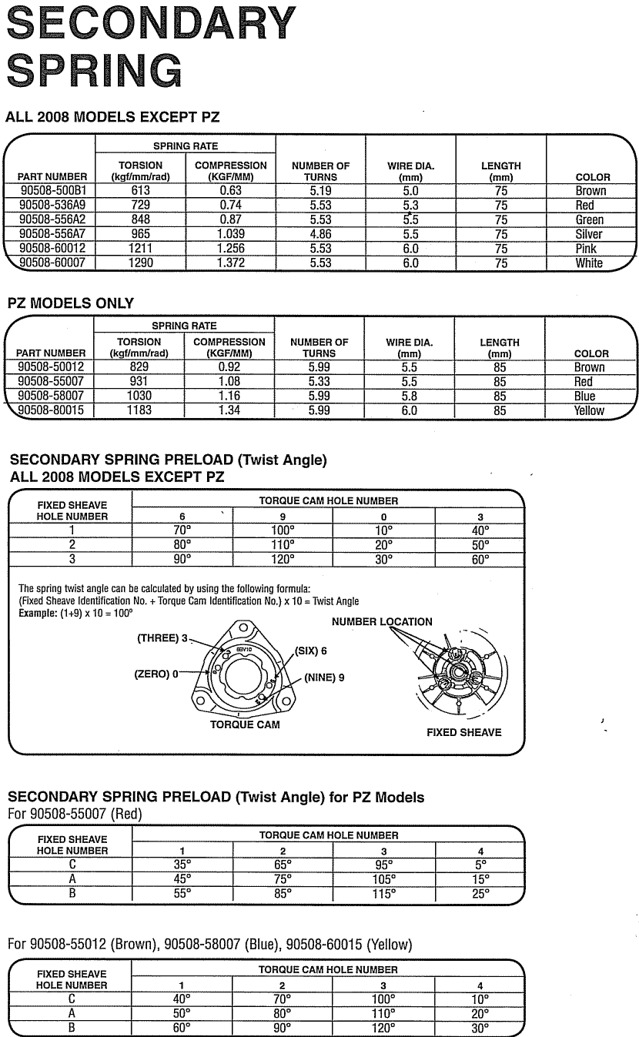
This image is from the tech section of the forum. Take a look at the bottom chart. It shows the letter of the hole in the sheave and the numbered hole for the helix and the resulting degrees of twist.
Keep in mind that even 10 degrees more is adding an increase of quite a few kg of side force.
Typically what you are trying to achieve is an increase in back shift when you add more degree of twist. This is and isn't what you think it is.
 Let's not think of back shifting as just when you let off the throttle. Although it obviously does do that too. Think of it as how quickly it recovers from you letting off the throttle.
Let's not think of back shifting as just when you let off the throttle. Although it obviously does do that too. Think of it as how quickly it recovers from you letting off the throttle. This is a little over simplification for hopefully ease of understanding. Keep in mind your clutches need balance. You can't have one trying to outdo the other.
Think of the secondary as a torque converter rather than a clutch. It has to sense input from the primary and adjust accordingly. When you are in the throttle it has to up shift in conjunction to the primary. Adding more twist to the helix can be thought of as adding resistance to up shift and increasing back shift. It is doing this by increasing the force needed for the sheave to climb the ramps of the helix. (more RPM) The extra resistance in the secondary requires more input from the primary to up shift. Helix angle also plays into this, but that is a story for another day.
Now, the secondary also has to sense input from the track and adjust accordingly to that too. Back shifting is actually what the secondary is doing to maintain RPM in changing conditions. If you suddenly jump off trail into waist deep powder your secondary will sense the added load from the track. Sensing this added load it needs to shift back into a lower gear. In an ideal setup it will do this without much change in RPM. And this is how the extra side pressure helps to maintain that rpm by causing it to back shift more rapidly.
A good comparison is a lake racer to a mountain rider. A lake racer is worried only about top speed so his secondary doesn't need to worry about back shifting. He just wants it to up shift very quickly. So they will run their spring tension on the low side. Just enough to grip the belt.
The mountain rider is constantly on and off the gas and is usually riding in deeper snow. His clutching needs to react very quickly to changes in throttle position and conditions. He is more worried about not being stuck than how fast his sled is. I'm sorry if this is confusing. Hit me with questions and I can try to explain it better.

87YAMAHA-570
New member
Finally my exciter is done... for now i fixed the fuel and putr new skis on and the stock bars... the track i got riped in the grass so i have a 1" camo one... tell me how it looks. the one picture is one of the old skis there is a hole worn in the keel no wonder i coundnt turn
Attachments
I read and i learn monte, you are a keeper u know that! Thanx for taking your time to learn an ignorant clerk rat like me these kind of things! 87yamaha570 that sled looks really good, love those skis!
stanage
Member
prankster said:No questions are stupid stanageI was thinking the same, i guess the angle depends on how much you turn the helix when u press it back in the splines. But how do i know when i hit 60 degrees?
btw stanage can i steal a pic on your sled from your fb? Got something goin on
DO IT! As long as you show what your up to after!
stanage
Member
Monte, that was another awesome lesson. I learned a lot. Seems as though I really need to take apart my secondary's and see if they're setup like Lasse says... I might have some time tmrw to check it out. I get the feeling the guy who had it before me had it setup for lake racing or something - with the gearing it has I'll bet the clutching is way off too...
